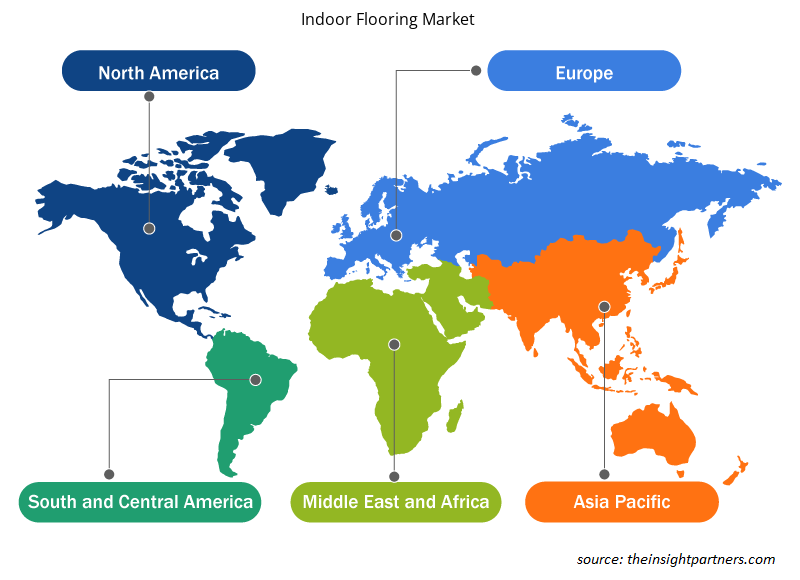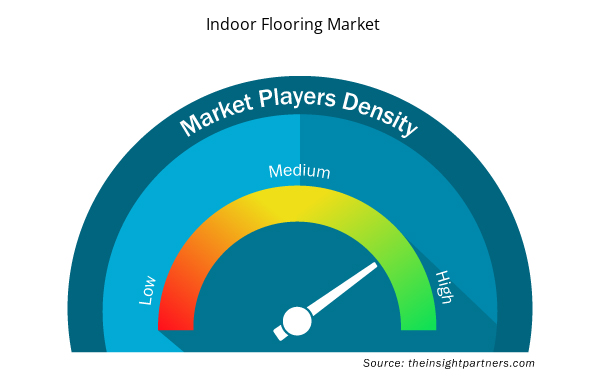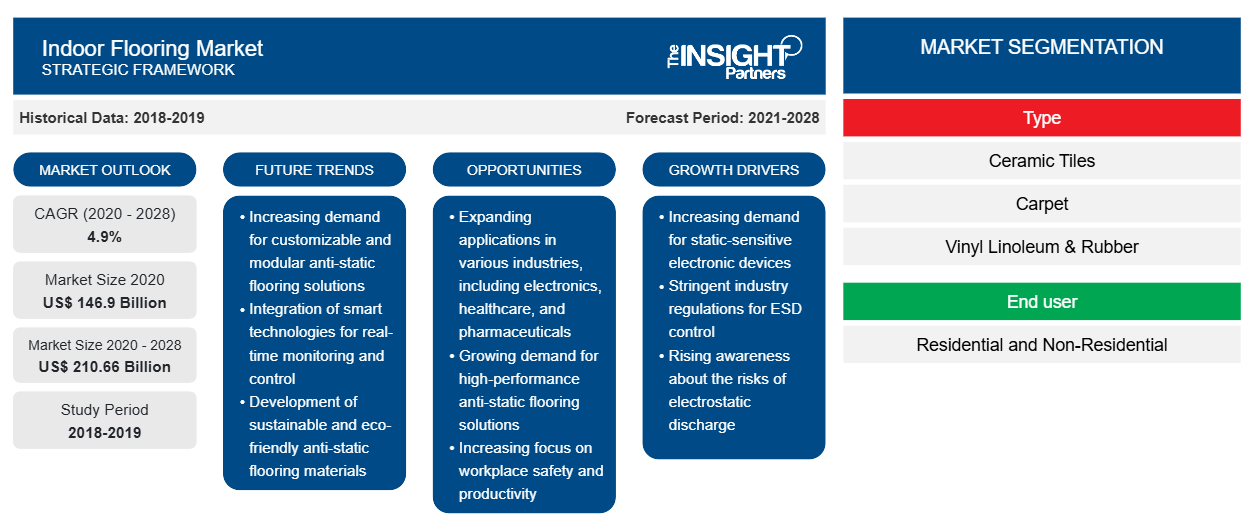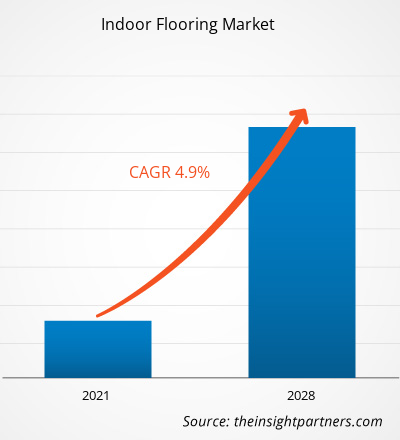[Informe de investigación] El mercado de pisos para interiores se valoró en US$ 146,90 mil millones en 2020 y se estima que crecerá a una CAGR del 4,9% durante el período de pronóstico de 2021 a 2028.
En entornos industriales como almacenes, hangares de aviones, plantas de ensamblaje, talleres de pintura, talleres de carrocería e instalaciones de distribución, los pisos de concreto están sujetos a desgaste por la exposición a productos químicos y aceites agresivos y corrosivos; también pueden dañarse por rayones y abrasiones causadas por máquinas y equipos pesados como aviones y carretillas elevadoras.
La rápida industrialización y el establecimiento de plantas de fabricación y procesamiento en las economías en desarrollo de la región APAC están impulsando la demanda de revestimientos para pisos, y las industrias farmacéutica, de alimentos y bebidas y de ensamblaje de automóviles son los principales generadores de demanda. Las corporaciones multinacionales de Europa y América están expandiendo sus operaciones en los países en desarrollo de la región APAC, como China e India. Con fabricantes de renombre que establecen sus instalaciones operativas en los países de esta región, la demanda de revestimientos para pisos de calidad industrial también está aumentando. El aumento de la demanda ha estado alentando a los fabricantes de pisos para interiores a introducir productos avanzados y genéricos, impulsando así el mercado de pisos para interiores.
Personalice este informe según sus necesidades
Obtendrá personalización en cualquier informe, sin cargo, incluidas partes de este informe o análisis a nivel de país, paquete de datos de Excel, así como también grandes ofertas y descuentos para empresas emergentes y universidades.
- Obtenga las principales tendencias clave del mercado de este informe.Esta muestra GRATUITA incluirá análisis de datos, desde tendencias del mercado hasta estimaciones y pronósticos.
Impacto de la pandemia de COVID-19 en el mercado de pisos para interiores
El brote de COVID-19 ha afectado significativamente al desarrollo de la infraestructura y a la economía global. La respuesta internacional a la rápida interrupción de los sectores e industrias clave de la infraestructura está en curso. Según el último informe de situación de la Organización Mundial de la Salud, Estados Unidos, India, Brasil, Rusia, el Reino Unido, Francia, España e Italia se encuentran entre los países más afectados debido al brote de COVID-19. El brote comenzó en Wuhan (China) en diciembre de 2019 y, desde entonces, se ha extendido por todo el mundo. La crisis de COVID-19 ha afectado a las industrias de todo el mundo. La economía mundial se vio afectada negativamente en 2020, lo que probablemente continuará en 2021. La pandemia ha perturbado a las empresas y proveedores de suelos de interior de todo el mundo. Los actores del mercado experimentaron interrupciones en sus operaciones y es probable que se enfrenten a consecuencias hasta mediados de 2021. Los cierres de fábricas, las prohibiciones comerciales y los cierres fronterizos han afectado negativamente a la industria de los suelos de interior. En el lado de las aletas, el mercado se abrirá en 2021, por lo que se espera que gane tracción en un futuro próximo.
Perspectivas del mercado de suelos para interiores
Uso creciente de revestimientos para suelos en complejos deportivos
Los sistemas de revestimiento de suelos utilizados en estadios deportivos interiores y exteriores necesitan la combinación adecuada de propiedades como una excelente elasticidad puntual, resistencia al deslizamiento, elasticidad superficial y rebote. También deben ser extremadamente duraderos, a la vez que muestran excelentes características ópticas y compatibilidad con los materiales colorantes y aditivos de uso común. Los revestimientos de suelo de poliuretano de alto rendimiento imparten una excelente elasticidad y un buen agarre a las superficies, al tiempo que permiten a los jugadores ser ágiles y moverse hábilmente en la cancha, lo que lo convierte en un material preferido para revestir suelos en pabellones deportivos interiores; canchas de tenis, voleibol y baloncesto; y pabellones de lucha libre y gimnasia. El aumento del gasto de los gobiernos y las empresas de construcción privadas en la construcción de complejos y estadios deportivos ha llevado al desarrollo de numerosas instalaciones deportivas en áreas urbanas y suburbanas, lo que probablemente generará una gran demanda de materiales especializados de alto rendimiento para suelos de interior en los próximos años.
Perspectivas del mercado basadas en tipos
Según el tipo, el mercado de suelos de interior se clasifica en baldosas de cerámica, moqueta, vinilo, linóleo y caucho, madera y laminado, entre otros. El segmento de baldosas de cerámica dominó el mercado de suelos de interior. Las baldosas de cerámica se utilizan ampliamente para mejorar los suelos de casas, habitaciones de hospitales y baños. Están ampliamente disponibles en el mercado. La cerámica también se conoce como porcelana. Las baldosas de cerámica también se utilizan para suelos y paredes. Están disponibles en una amplia gama de variedades basadas en texturas, patrones y tamaños. En los mercados globales y locales, muchos actores ofrecen diferentes tipos de productos relacionados.
Los actores que operan en el mercado de pisos para interiores se centran en estrategias como fusiones, adquisiciones e iniciativas de mercado para mantener sus posiciones en el mercado. A continuación, se enumeran algunos avances de los actores clave:
- En 2020, según fuentes de desarrollo económico estatales y locales, Shaw Industries Group invirtió 20 millones de dólares para construir un nuevo espacio en Ringgold. La empresa planea ocupar el nuevo espacio en Ringgold el 1 de junio de 2021 aproximadamente.
- En 2018, Interface amplía su alcance en el sector de los suelos de alto rendimiento con la adquisición de una empresa de suelos de caucho
Perspectivas regionales del mercado de suelos para interiores
Los analistas de Insight Partners explicaron en detalle las tendencias y los factores regionales que influyen en el mercado de suelos para interiores durante el período de pronóstico. Esta sección también analiza los segmentos y la geografía del mercado de suelos para interiores en América del Norte, Europa, Asia Pacífico, Oriente Medio y África, y América del Sur y Central.

- Obtenga datos regionales específicos para el mercado de pisos para interiores
Alcance del informe de mercado de suelos para interiores
| Atributo del informe | Detalles |
|---|---|
| Tamaño del mercado en 2020 | US$ 146,9 mil millones |
| Tamaño del mercado en 2028 | US$ 210,66 mil millones |
| Tasa de crecimiento anual compuesta (CAGR) global (2020-2028) | 4,9% |
| Datos históricos | 2018-2019 |
| Período de pronóstico | 2021-2028 |
| Segmentos cubiertos | Por tipo
|
| Regiones y países cubiertos | América del norte
|
| Líderes del mercado y perfiles de empresas clave |
|
Densidad de actores del mercado de suelos para interiores: comprensión de su impacto en la dinámica empresarial
El mercado de suelos para interiores está creciendo rápidamente, impulsado por la creciente demanda de los usuarios finales debido a factores como la evolución de las preferencias de los consumidores, los avances tecnológicos y una mayor conciencia de los beneficios del producto. A medida que aumenta la demanda, las empresas amplían sus ofertas, innovan para satisfacer las necesidades de los consumidores y aprovechan las tendencias emergentes, lo que impulsa aún más el crecimiento del mercado.
La densidad de actores del mercado se refiere a la distribución de las empresas o firmas que operan dentro de un mercado o industria en particular. Indica cuántos competidores (actores del mercado) están presentes en un espacio de mercado determinado en relación con su tamaño o valor total de mercado.
Las principales empresas que operan en el mercado de suelos para interiores son:
- Forbo Internacional SA
- Esteras Inc.
- Tarkett
- Pisos Armstrong, Inc.
- Grupo Internacional Beaulieu
Descargo de responsabilidad : Las empresas enumeradas anteriormente no están clasificadas en ningún orden particular.

- Obtenga una descripción general de los principales actores clave del mercado de pisos para interiores
El mercado mundial de suelos de interior se ha segmentado de la siguiente manera:
Mercado mundial de suelos para interiores: por tipo
- Azulejos de cerámica
- Alfombra
- Linóleo vinílico y caucho
- Madera y laminado
- Otros
Mercado mundial de suelos para interiores (por usuario final)
- Residencial
- No residencial
Mercado mundial de suelos para interiores, por geografía
- América del norte
- A NOSOTROS
- Canadá
- México
- Europa
- Francia
- Alemania
- Italia
- Rusia
- Reino Unido
- Resto de Europa
- Asia Pacífico (APAC)
- Porcelana
- India
- Japón
- Australia
- Corea del Sur
- Resto de APAC
- Oriente Medio y África (MEA)
- Arabia Saudita
- Emiratos Árabes Unidos
- Sudáfrica
- Resto de MEA
- América del Sur y Central (SCAM)
- Brasil
- Argentina
- Resto de estafa
Perfiles de empresas
- Forbo Internacional SA
- Esteras Inc.
- Tarkett
- Pisos Armstrong, Inc.
- Grupo Internacional Beaulieu
- Ecore Internacional
- Interfaz, Inc.
- Corporación Toli
- Industrias Mohawk, Inc.
- Grupo de Industrias Shaw, Inc.
- Análisis histórico (2 años), año base, pronóstico (7 años) con CAGR
- Análisis PEST y FODA
- Tamaño del mercado Valor/volumen: global, regional, nacional
- Industria y panorama competitivo
- Conjunto de datos de Excel


- Retinal Imaging Devices Market
- Industrial Inkjet Printers Market
- Industrial Valves Market
- Data Annotation Tools Market
- Flexible Garden Hoses Market
- Vision Guided Robotics Software Market
- Vessel Monitoring System Market
- Energy Recovery Ventilator Market
- Equipment Rental Software Market
- Nurse Call Systems Market

Report Coverage
Revenue forecast, Company Analysis, Industry landscape, Growth factors, and Trends

Segment Covered
This text is related
to segments covered.

Regional Scope
North America, Europe, Asia Pacific, Middle East & Africa, South & Central America

Country Scope
This text is related
to country scope.
Preguntas frecuentes
The indoor flooring market is led by ceramic tiles segment with highest share and is expected to dominate in the forecast period. The ceramic tiles are widely used to enhance the floors of houses, hospital rooms, toilets, and others. It is extensively available in the market. It is also known as porcelain. The ceramic tiles are used for flooring and walls. It is available in a broad range of varieties based on textures, patterns, and sizes. In the global and the local markets, many players offer different types of related products
Rise in number of commercial and residential construction projects. Moreover, surge in product innovations and launches, thereby substantially driving the automated guided vehicles (AGV) market.
Floors coating systems used in indoor and outdoor sports arenas need the right combination of properties such as excellent point elasticity, skid resistance, surface elasticity, and rebound properties. They should also be extremely durable, while displaying excellent optical characteristics and compatibility with commonly used coloring materials and additives. High-performance polyurethane floor coatings impart excellent elasticity and good grip to surfaces while allowing players to be agile and move skillfully on the court, which makes it a preferred material for coating floors in indoor sports halls; tennis, volleyball, and basketball courts; and wrestling and gymnastic halls. The rising expenditure by government and private construction companies in building sports complexes and arenas has led to the development of numerous sports facilities in urban as well as suburban areas, which are likely to generate a high demand for specialized high-performance indoor flooring materials in the coming years.
Trends and growth analysis reports related to Manufacturing and Construction : READ MORE..
The List of Companies - Indoor Flooring Market
- Forbo International SA
- Mats Inc.
- Tarkett
- Armstrong Flooring, Inc.
- Beaulieu International Group
- Ecore International
- Interface, Inc.
- Toli Corporation
- Mohawk Industries, Inc.
- Shaw Industries Group, Inc.
The Insight Partners performs research in 4 major stages: Data Collection & Secondary Research, Primary Research, Data Analysis and Data Triangulation & Final Review.
- Data Collection and Secondary Research:
As a market research and consulting firm operating from a decade, we have published and advised several client across the globe. First step for any study will start with an assessment of currently available data and insights from existing reports. Further, historical and current market information is collected from Investor Presentations, Annual Reports, SEC Filings, etc., and other information related to company’s performance and market positioning are gathered from Paid Databases (Factiva, Hoovers, and Reuters) and various other publications available in public domain.
Several associations trade associates, technical forums, institutes, societies and organization are accessed to gain technical as well as market related insights through their publications such as research papers, blogs and press releases related to the studies are referred to get cues about the market. Further, white papers, journals, magazines, and other news articles published in last 3 years are scrutinized and analyzed to understand the current market trends.
- Primary Research:
The primarily interview analysis comprise of data obtained from industry participants interview and answers to survey questions gathered by in-house primary team.
For primary research, interviews are conducted with industry experts/CEOs/Marketing Managers/VPs/Subject Matter Experts from both demand and supply side to get a 360-degree view of the market. The primary team conducts several interviews based on the complexity of the markets to understand the various market trends and dynamics which makes research more credible and precise.
A typical research interview fulfils the following functions:
- Provides first-hand information on the market size, market trends, growth trends, competitive landscape, and outlook
- Validates and strengthens in-house secondary research findings
- Develops the analysis team’s expertise and market understanding
Primary research involves email interactions and telephone interviews for each market, category, segment, and sub-segment across geographies. The participants who typically take part in such a process include, but are not limited to:
- Industry participants: VPs, business development managers, market intelligence managers and national sales managers
- Outside experts: Valuation experts, research analysts and key opinion leaders specializing in the electronics and semiconductor industry.
Below is the breakup of our primary respondents by company, designation, and region:

Once we receive the confirmation from primary research sources or primary respondents, we finalize the base year market estimation and forecast the data as per the macroeconomic and microeconomic factors assessed during data collection.
- Data Analysis:
Once data is validated through both secondary as well as primary respondents, we finalize the market estimations by hypothesis formulation and factor analysis at regional and country level.
- Macro-Economic Factor Analysis:
We analyse macroeconomic indicators such the gross domestic product (GDP), increase in the demand for goods and services across industries, technological advancement, regional economic growth, governmental policies, the influence of COVID-19, PEST analysis, and other aspects. This analysis aids in setting benchmarks for various nations/regions and approximating market splits. Additionally, the general trend of the aforementioned components aid in determining the market's development possibilities.
- Country Level Data:
Various factors that are especially aligned to the country are taken into account to determine the market size for a certain area and country, including the presence of vendors, such as headquarters and offices, the country's GDP, demand patterns, and industry growth. To comprehend the market dynamics for the nation, a number of growth variables, inhibitors, application areas, and current market trends are researched. The aforementioned elements aid in determining the country's overall market's growth potential.
- Company Profile:
The “Table of Contents” is formulated by listing and analyzing more than 25 - 30 companies operating in the market ecosystem across geographies. However, we profile only 10 companies as a standard practice in our syndicate reports. These 10 companies comprise leading, emerging, and regional players. Nonetheless, our analysis is not restricted to the 10 listed companies, we also analyze other companies present in the market to develop a holistic view and understand the prevailing trends. The “Company Profiles” section in the report covers key facts, business description, products & services, financial information, SWOT analysis, and key developments. The financial information presented is extracted from the annual reports and official documents of the publicly listed companies. Upon collecting the information for the sections of respective companies, we verify them via various primary sources and then compile the data in respective company profiles. The company level information helps us in deriving the base number as well as in forecasting the market size.
- Developing Base Number:
Aggregation of sales statistics (2020-2022) and macro-economic factor, and other secondary and primary research insights are utilized to arrive at base number and related market shares for 2022. The data gaps are identified in this step and relevant market data is analyzed, collected from paid primary interviews or databases. On finalizing the base year market size, forecasts are developed on the basis of macro-economic, industry and market growth factors and company level analysis.
- Data Triangulation and Final Review:
The market findings and base year market size calculations are validated from supply as well as demand side. Demand side validations are based on macro-economic factor analysis and benchmarks for respective regions and countries. In case of supply side validations, revenues of major companies are estimated (in case not available) based on industry benchmark, approximate number of employees, product portfolio, and primary interviews revenues are gathered. Further revenue from target product/service segment is assessed to avoid overshooting of market statistics. In case of heavy deviations between supply and demand side values, all thes steps are repeated to achieve synchronization.
We follow an iterative model, wherein we share our research findings with Subject Matter Experts (SME’s) and Key Opinion Leaders (KOLs) until consensus view of the market is not formulated – this model negates any drastic deviation in the opinions of experts. Only validated and universally acceptable research findings are quoted in our reports.
We have important check points that we use to validate our research findings – which we call – data triangulation, where we validate the information, we generate from secondary sources with primary interviews and then we re-validate with our internal data bases and Subject matter experts. This comprehensive model enables us to deliver high quality, reliable data in shortest possible time.


 Obtenga una muestra gratuita de este informe
Obtenga una muestra gratuita de este informe